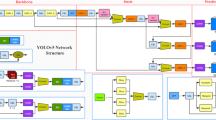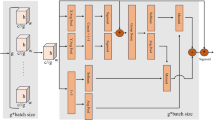Abstract
Bus passenger flow statistics can be used to improve passenger travelling experience and reduce trip delay, this is very important for intelligent transportation. In this paper, a bus passenger flow statistics algorithm based on SSD (Single Shot MultiBox Detector) and Kalman filter is proposed to obtain passenger flow statistics from surveillance cameras on the buses. The method modifies the SSD model to a two-class model and trains the two-class SSD model using the bus dataset first, then the model is used to detect the position of the passengers in each frame and are tracked with the Kalman filter. Finally, according to the passenger trajectory, the traffic statistics of passenger getting on and off will be generated. The results of some conducted experiments show that the proposed bus passenger flow statistics algorithm is more accurate and robust than traditional methods.












Similar content being viewed by others
References
Boggavarapu R K, Pateriya P K. Efficient method for counting and tracking of moving objects through region segmentation[C]. IEEE Int Conference Comput Intell Comput Res 2016: 1–6.
Cai W, Wei Z (2020) PiiGAN: generative adversarial networks for pluralistic image Inpainting. IEEE Access 8:48451–48463
Chao-Ho Chen, Yin-Chan Chang, Tsong-Yi Chen, et al. People Counting System for Getting In/Out of a Bus Based on Video Processing[C]//Eighth International Conference on Intelligent Systems Design and Applications 2008:565–569.
Deng W, Binghan L (2018) Deep learning-based pedestrian detection combined with semantics[J]. Comput Syst Appl 27(06):165–170
R. Girshick. Fast R-CNN [C]//IEEE International Conference on Computer Vision (ICCV), 2015:1440–1448.
R. Girshick, J. Donahue, T. Darrell, and J. Malik, Rich feature hierarchies for accurate object detection and semantic segmentation [C]//IEEE Conference on Computer Vision and Pattern Recognition (CVPR), 2014:580–587.
Jiajun W, Xu Y, Yinwei Z (2011) People counting based on Ada boost and inter-frame features[J]. J Image Graphics 16(9):1729–1735
Junjun Z, Zhiguang S, Jicheng L (2018) Current researches and future perspectives of crowd counting and crowd density estimation technology[J]. Co Eng Sci 40(02):282–291
Kalman RE (1960) A new approach to linear filtering and prediction problems[J]. Trans ASME-J Basic Eng 82:35–45
A. Krizhevsky, I. Sutskever, and G. Hinton. ImageNet classification with deep convolutional neural networks. [C]//Conference and Workshop on Neural Information Processing Systems(NIPS), 2012.
Lei L, Zehong C, Yong Z et al (2017) A people counting algorithm based on multi-feature of head region in depth images[J]. J Shenzhen Univ Sci Eng 34:584–590
Li B, Zhang J, Zhang Z, et al. A people counting method based on head detection and tracking[C]. Int Conference Smart Comput 2014:136–141.
Wei Liu, Dragomir Anguelov, Dumitru Erhan. SSD: Single Shot MultiBox Detector [C]// European Conference on Computer Vision (ECCV) 2016:21–37.
J. Redmon, S. Divvala, R. Girshick, and A. Farhadi. You only look once: Unified, real-time object detection. [C]//IEEE Conference on Computer Vision and Pattern Recognition. 2016:779–788.
Shaoqing Ren, Kaiming He, Ross Girshick. Faster R-CNN: towards real-time object detection with region proposal networks [J]. IEEE Trans Pattern Anal Mach Intell 2016:1137–1149.
K. Simonyan and A. Zisserman, Very deep convolutional networks for large-scale image recognition. [C]//International Conference on Learning Representations (ICLR). 2015:1150–1210.
H. S. Song, S. J. Sun, N. Akhtar, C. Y. Zhang, J. X. Li, A. Mian. Benchmark data and method for real-time people counting in cluttered scenes using depth sensors. arXiv:1804.04339,2018.
Vu T H, Osokin A, Laptev I. Context-aware CNNs for person head detection[C]. Proceedings of the IEEE International Conference on Computer Vision. 2015: 2893–2901.
Wang Z, Zou C, Cai W (2020) Small sample classification of Hyperspectral remote sensing images based on sequential joint Deeping learning model. IEEE Access 8:71353–71363
You H, Tian S, Yu L, Lv Y (Feb. 2020) Pixel-level remote sensing image recognition based on bidirectional word vectors. IEEE Trans Geosci Remote Sens 58(2):1281–1293
Zheng G, Zhu Q, Wang H (2017) Indoor video people statistics based on deep learning SSD model[J]. J Ind Control Comput 30(11):48–50
Acknowledgments
This work was supported by the Foundation of Nature Science of Guangdong (2015A030310172).
Author information
Authors and Affiliations
Corresponding author
Additional information
Publisher’s note
Springer Nature remains neutral with regard to jurisdictional claims in published maps and institutional affiliations.
Rights and permissions
About this article
Cite this article
Zhang, Y., Tu, W., Chen, K. et al. Bus passenger flow statistics algorithm based on deep learning. Multimed Tools Appl 79, 28785–28806 (2020). https://doi.org/10.1007/s11042-020-09487-0
Received:
Revised:
Accepted:
Published:
Issue Date:
DOI: https://doi.org/10.1007/s11042-020-09487-0




